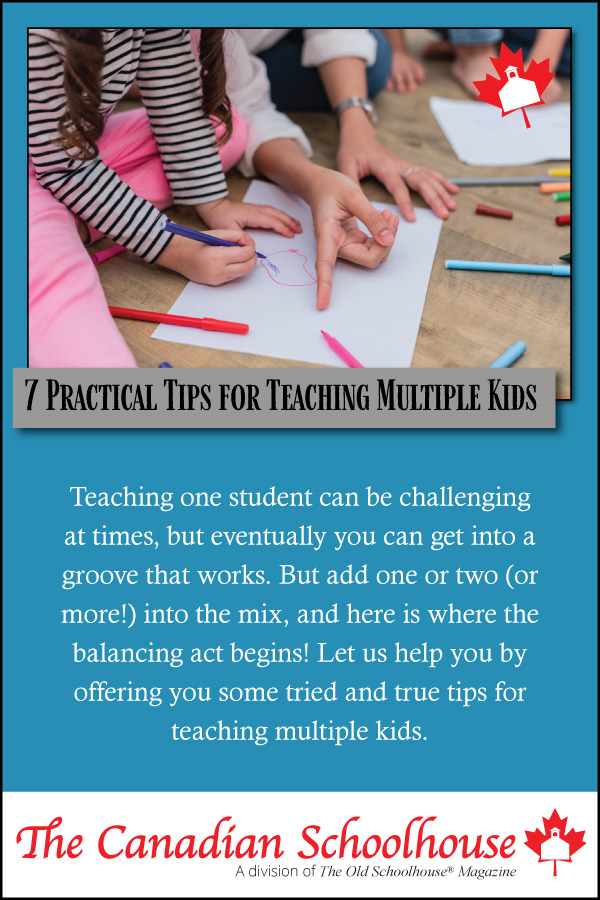

Teaching one student can be challenging at times, but eventually you can get into a groove that works. But add one or two (or more!) into the mix, and here is where the balancing act begins! Let us help you by offering you some tried and true tips for teaching multiple kids.
Here are 7 helpful tips:
-
-
Do Family Read-Alouds - Find books that you can read together as a family. Save time and get your children engaged by discussing it together after reading. You can even turn it into something special like having “Tea Time” as they quietly listen while enjoying yummy treats! If you want to extend the learning, you can have them write responses to what you read, adjusting expectations for different ages. Preschoolers could draw something from the section you read, early elementary could draw a picture and write one sentence about what was read, and so on.
-
Get Older Siblings Involved - If you have older siblings that are able to help with some activities or reading, then start assigning some tasks for them to help out more. They could help by reading a text or reading instructions to help the younger one get started, or they could teach or do a simple craft with them. Older siblings can also teach on a subject that they have already learned, giving you the opportunity to gauge how well the older sibling has grasped the subject as well. The ability to teach something is the greatest evidence of retention.
-
Make Use of Online Learning - Having help from an online course will especially help with an older child, and they can be instructed by the online video or instructor while you have time to attend to the younger children. You can choose a specific online curriculum where all learning in that subject happens online, or you can utilize some of the many apps and games that are available.
-
Do Unit Studies - Doing a unit study together allows for you to teach different ages all in one subject while adjusting your assignments as needed to match the level of learning required. You can have your children be a part of the selection process and choose topics that are of interest to everyone, making the learning process more enjoyable. This is especially useful for subjects like Bible, science, and social studies as they don’t build on subject matter from year to year. There are some different companies that make units to this nature such as Gather Round Homeschool, The Good and The Beautiful, Masterbooks and Apologia.
.

. -
Do Projects Together - Subjects like art and science can be done together as well. Whether it’s painting, crafts or science experiments, you can all work together as a family and have discussions as you go and save on time in the process.
-
Centres / Stations - This is a great option, especially if you have multiple young children. You can set up various stations or centres, one per child that you have participating. Have one station be one-on-one time with mom where you do their focused bookwork or teaching while the others are independent. Some ideas could be:
- Fun play with toys that only come out at this time
- Puzzles
- Playdough
- Hands-on learning activities if you have them, like this see and spell activity
- Independent work, like printing practice
- Review work
- Learning apps
.
The Homeschool Mom blog offers some other awesome suggestions for learning stations. Get creative, and this can be a helpful way to manage multiple little ones. Set a timer and get started.
-
Be Flexible - Remember, one of the joys of homeschooling is that you have the opportunity to be flexible. Some days, some subjects won’t get done and that’s okay. You can always pick it up later. Homeschooling allows for flexibility to go at a different pace for each child so take your time with it and don’t feel bad about not checking things off the list each day. Remember that classrooms aren’t quiet or free of distractions and neither does your home need to be. Working with distractions can help develop focus skills. Don’t worry about it; just carry on and enjoy!
The time you spend with your children is the most important part of homeschooling. Whether you complete a subject or not, the opportunity to get to know more about your child, what he or she likes, and getting them to engage in conversations will be beneficial to everyone.
This article has been written by homeschooling staff writers of The Canadian Schoolhouse (TCS). Enjoy more of our content from TCS contributors and staff writers by visiting our Front Door page that has content on our monthly theme and links to all our content sections.
-














